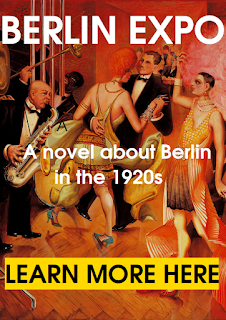But if BZ am
Mittag had been the first tabloid, it did not stay long alone.
The very rightist Nachtausgabe, owned by the millionaire
Alfred Hugenberg, was launched in 1922, as an evening edition of his
newspaper Der Tag. And in 1925, Communist deputy Willi Münzenberg,
known as "the red Hugenberg", bought the left-wing
newspaper "Die Welt am Abend", with a print run of
just 3,000 and turned it into a successful daily newspaper. While
being openly communist, the paper avoided the dogmatism of Die
Rote Fahne, organ of the Party, and addressed a public which went
beyond the extreme left.
The reason most
often invoked by KPD members for not reading the Rote Fahne
was that the party organ was not entertaining enough. A reader
specified his expectations: 'I would like to read something about the
natural sciences, literature, crime, in short, I want to feel the
pulse of life. . . not always politics and more politics. »
Readers demanded local news, illustrated supplements, serialized
novels and a cover of "bourgeois sports" (especially
football).
As
one female party member explained it was difficult to compete with
the bourgeois press and its ‘Interesting News from Around the
World’, Letter Box, Household Chat, Fashion Templates and the like.
One female Berliner Morgenpost reader explained she was
quite satisfied ‘that there is at least one newspaper which reports
as good as nothing on politics’. Although this was not necessarily
an accurate account of the Morgenpost’s offerings, it
reflected the widespread consensus that the
entertainment
provided by the Ullstein paper was the decisive buying factor. Women
generally did not hold back with their criticism of the Communist
party organ. Numerous reports tell of quarrels within the family
about the Communist party organ, with cases of wives cancelling the
subscription to the Rote Fahne and ordering the Berliner
Morgenpost instead. When not subscribing to the Morgenpost
themselves, many women shared the newspaper with a neighbour’s
wife. A common reply of non-Rote Fahne readers was ‘that I
also have a wife and that she would raise hell if I were to cancel
the Motte [Morgenpost] and would subscribe instead to the
[Rote] Fahne . . . And in order . . . to have peace and calm
at home I adhere to my wife’s wishes in this regard.’
One
prosaic reason suggested was that these newspapers simply offered
more paper and that readers did not care whether their wrapping paper
contained editorial text or advertisements. This was not entirely
facetious: in the absence of plastic, newsprint was a crucial element
in any household and value for money was not only measured in terms
of content.
The
Rote Fahne failed to appeal to women just like the KPD failed
to appeal to the female electorate.
« Press
and politics in the Weimar Republic », by Bernhard Fulda,
Oxford University Press, 2009.
But if the Communists did not read the Fahne that often, they willingly read another red newspaper : Welt am Abend. It was read ten times more than Rote Fahne, a fact that the Communist Party (KPD) didn’t like. But they could not blame Münzenberg for being successful. Because the good Willi was a born organizer, coupled with a brilliant propagandist. He had probably never read Das Kapital, but he was doing more for the Marxist cause than all the apparatchiks of the KPD. And his success was not limited to Welt am Abend; he had built a whole media empire. A.I.Z., a sort of Communist Life Magazine, was also a success. Not to mention Prometheus Film, which stood behind several famous productions
Münzenberg’s
independence annoyed the party bureaucrats and, when the day came, he
was duly punished. Exiled in France because of the Nazis, his body
was found a rope around his neck in a wood. Suicide? Assassination by
Stalin's orders, rather.
But back to Berlin
and to Welt am Abend. It had about ten pages: three or four on
politics, one with news from Berlin, one with soap operas, two about
culture, film and theater, a sports page, and the economy. The
advertisement occupied a whole page. Each edition contained photos,
drawings and some caricatures. The focus was on entertainment, as
shown by the space devoted to serialized novels. Welt am Abend
could proposed 'Jack the Ripper: Revelations about the life of a
sexual murderer' (the Nachtausgabe proposed on its side
'Nelly is disappointed by men! A brunette’s novel'. )
For example: the
first page of the April 6, 1932 issue is devoted to the trial of the
two men who had tried to murder the German ambassador in Moscow. "An
act intended to provoke an armed intervention of the capitalist
powers against the workers' state. "
In the following
pages the fact is stated that the Prussian Minister of the Interior,
the Social Democrat Severing, has passively assisted while the SA
were arming themselves. Swedish millionaire Ivar Kreuger, who has
recently committed suicide in Paris, is now proved to have been a
forger, proclaims Welt am Abend: in his safe deposit box,
falsified Italian state bonds have been found.
Then, the second
part of a series on corruption in the National Socialist elite.
Technical progress makes it possible to envisage electric prostheses
in the future. "Red sportsmen in action": sportsmen are
supporting Thälmann, the communist candidate for the Reich
presidency.
An advertisement for
Kurt Tucholsky's book "Deutschland, Deutschland über alles",
illustrated by John Heartfield. "Not the kind of book you read
once and then leave aside". 236 pages of the best paper. Kosmos
editions. Price reduced from 3 mark to 1.50 mark.
Two serialized
novels: Fort-Vaux, by Ernst Glaeser and Gold-diggers and
hunters in Grand-Chaco, by Walter Burkart.
Among the authors
that had contributed to the journal are Egon Erwin Kisch, Alfred
Döblin, Lion Feuchtwanger, Kurt Tucholsky, Erich Mühsam, Thomas
Mann and Georg Lukács.



No comments:
Post a Comment